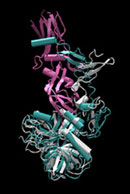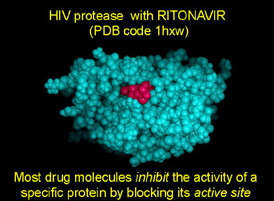

Maria I. Zavodszky
Research Assistant Professor
- B.S. 1984, Babes-Bolyai University, Cluj, Romania
- M.S. 1999, Kansas State University
- Ph.D. 2003, Michigan State University
zavodszm@ge.com
505 Biochemistry Building
Michigan State University
East Lansing, MI 48824-1319
Phone: 517-432-7177
Fax: 517-353-9334
Lab Home Page
Publication search:
Maria I. Zavodszky Research Interests
I. Modeling flexibility at protein-protein interfaces
 The ability to reconstruct and study biological pathways greatly depends on how well we can predict the mode of interaction between the elements of the pathways, which are usually proteins of various functions. Given the structures of the free proteins, current computational docking tools cannot predict the structure of the bound complex when one or both or the binding partners undergo large conformational changes. Based on flexibility analysis of the unbound structure using the graph-theoretical algorithm FIRST, it is possible to predict what parts of the protein are most likely to undergo conformational changes. Large-scale movements of the predicted flexible parts can be modeled using clever algorithms that sample only the low frequency modes of the possible motions.
The ability to reconstruct and study biological pathways greatly depends on how well we can predict the mode of interaction between the elements of the pathways, which are usually proteins of various functions. Given the structures of the free proteins, current computational docking tools cannot predict the structure of the bound complex when one or both or the binding partners undergo large conformational changes. Based on flexibility analysis of the unbound structure using the graph-theoretical algorithm FIRST, it is possible to predict what parts of the protein are most likely to undergo conformational changes. Large-scale movements of the predicted flexible parts can be modeled using clever algorithms that sample only the low frequency modes of the possible motions.
II. The role of protein flexibility and dynamics in ALS
Mutations in the superoxide dismutase (SOD1) gene on chromosome 2 have been shown to cause familial Amyotrophic Lateral Sclerosis (ALS), a fatal motor neuron disease. Analyzing and comparing the flexibility and dynamics of the wild-type and various mutant forms of SOD1 can shed light to the likely mechanism by which these mutations cause ALS: either by altering the catalytic function of the mutant protein, such that it damages the affected cells, or by inducing changes in structure, destabilizing the active dimer and making the protein sticky and prone to aggregation. Depending on which mechanism proves to be responsible for the disease, inhibitors can be identified to inhibit the altered function, or drug-like ligands can be designed to bind and stabilize the dimer.
III. Designing filter-functions to identify near-native protein-ligand complexes
Docking is the computational prediction of how ligands binds to their target protein. Docking programs usually produce hundreds or even thousands of possible binding modes. The key challenge is to decide which one of these predicted binding modes is the most favorable energetically and is most likely to be observed experimentally.
IV. Structure-based computational screening
I am working on identifying new ligands/inhibitors by computational screening to a number of different protein targets relevant for disease therapy:
 Urokinase-type plasminogen activator (uPA) plays a key role in tumor invasion and metastasis. High levels of uPA in primary tumor tissues are associated with unfavorable prognosis with high risk of disease recurrence.
Urokinase-type plasminogen activator (uPA) plays a key role in tumor invasion and metastasis. High levels of uPA in primary tumor tissues are associated with unfavorable prognosis with high risk of disease recurrence.
Arachidonic acid metabolizing lipoxygenase
(P-12-LOX) is involved in prostate cancer progression: the level of P-12-LOX expression increases at advanced stages of the disease; overexpression of P-12-LOX in human prostate cancer cells stimulates angiogenesis and tumor growth; an inhibitor of P-12-LOX was found to slow down metastasis.
The work of finding ligands for the above two targets is part of a collaboration with Jerzy Jankun (http://golemxiv.dh.meduohio.edu/~jerzy/) and Ewa Skrzypczak-Jankun (http://golemxiv.dh.meduohio.edu/~ewa/) from the Medical University of Ohio.
YIqF is an essential GTPase in the assembly of ribosomal subunit 50S in the bacterium Bacillus subtilis. Small molecules or peptides that bind to this protein can disrupt ribosome biogenesis. This is a project in collaboration with Rob Britton from the Department of Microbiology at MSU (http://www.msu.edu/~rbritton/).